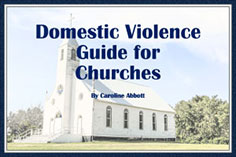***Trigger Warning***
On May 17, I took a webinar hosted by the National Coalition of Domestic Violence (NCADV) entitled “Prosecuting Domestic Violence Cases: Efforts to Balance Serving Society and Survivors within a Multidisciplinary Team Framework.“ This webinar was presented by Jason Emmanuel and Daniel E. Lewis who are both Assistant State’s Attorneys from the St. Clair County, Illinois prosecutors office. I learned a lot about this process. Since many of you may be currently experiencing this, or will in the future, I and would like to share an overview of it for you.
St. Clair County has a substantial number of reports of domestic violence –
- In 2011, the number of reported domestic offenses per 100,000 people was approximately 246.9 (ICJIA, Illinois Statistical Analysis Center, Detailed Data Table). St. Clair County also has a very high rate of general violent and nonviolent crime.
- The rate of Orders of Protection was 424.4 per 100,000 population, also a 10- year high (ICJIA, Illinois Statistical Analysis Center, Detailed Data Table).
East St. Louis is part of St. Clair County, and is frequently reported to be one of the most violent cities in the United States. According to data provided by the Illinois State Police, East Saint Louis had the highest per capita murder in the country in 2011, which was twenty times the national average and five times greater than the city of Chicago.
St. Clair County has a Domestic Violence and Special Victims Unit that is a VAWA grant funded unit that consists of:
- Three Assistant State’s Attorneys (including the supervisor)
- Advocates from the Violence Prevention Center of Southwestern Illinois
- An advocate from Call 4 Help Inc. (A sexual assault counseling and advocacy organization)
- A probation officer dedicated to exclusively supervising domestic offenders
- Two Sheriff’s Deputies who respond to calls, serve Orders of Protection, and serve subpoenas to witnesses in DV cases.
St. Clair County State’s Attorney’s office has an aggressive charging stance. They formally charged 68% of cases that were applied for in the first quarter of 2017. And upward of 81% of the cases resulted in a conviction or other favorable disposition (plea).
The St. Clair County State’s Attorney’s office mantra is:
“There is no criminal justice without social justice and there is no social justice without criminal justice.”  Tweet This
Tweet This
This county uses a “victimless prosecution” model. This means that DV victims don’t have to press charges against their abusers, the county’s Attorney’s office does it for them. This model insulates the victim from being responsible for the court proceedings.
Here are the stages of a criminal prosecution:
- Law enforcement response – When an officer goes out for a DV call, they try to discern who is the offender and who is the victim. They will arrest a person when there is a “probable cause” that the person committed a crime. Probable cause is defined in terms of facts and circumstances ‘sufficient to warrant a prudent man in believing that the (suspect) had committed or was committing an offense.’ Beck v. Ohio, 379 U.S. 89, 91, (1964). They noted that the vast majority of police officers want to do the right thing. Officers are often overworked and under trained about the dynamics of domestic violence. DV calls are the most dangerous types of calls to police, and officers are often injured or killed. In this county, DV Advocates attempt to contact survivors to offer services within 24 hours. Advocates have made great strides in educating the police department about the dynamics of abuse.
- Warrant application – An offender can be held only 48 hours if there is no warrant. Police can get a warrant to charge the offender if there is probable cause. Getting a warrant might take time, often longer than the 48 hours the offender will be held in jail. DV survivors would be wise to stay away from the offender during this time, because they might be harmed, or coerced into recanting (lying about what happened). Survivors are also encouraged to make additional police reports during this time. They might think of additional things that have occurred that can be added to the police report. Also, bruises take a few days to develop, so the victim can show them to the police, and add any medical records into the report.
- Charging Decision – While police can arrest an offender with probably cause, prosecutors decide whether to charge the offender based on a reasonable likelihood of conviction. This means if a case goes before a judge or jury, is there a reasonable likelihood that the offender will be convicted? Therefore, an offender may be arrested but not charged with a crime. The prosecutor’s office can charge the offender, decline to charge, or take the case under advisement – meaning they send the case back to the police to obtain additional evidence. How do prosecutors decide? They look at:
- Are there independent witnesses?
- Are there injuries? If so, who has the injuries? Are the injuries offensive or defensive wounds?
- Has this offender been reported before?
- Was either the offender or the victim intoxicated?
- Is there a clear predominant aggressor? (I.e. is it clear who was the offender?)
Most cases will be declined if there is no audio/video recorded, or no additional witnesses. Sometimes a survivor will become frightened later and recant, saying they hit the offender first, or the police lied. It is very difficult to prosecute a case when the survivor recants.
4. Probable Cause Hearing – If / When a Warrant is issued and a person is held on that warrant they have a constitutional right to a probable cause hearing. There are two ways this can occur:
- Grand Jury (Complaint or inquiry) – The case is presented by a prosecuting attorney to a panel of community members where one or more witnesses may be called to establish the facts and that probable cause exists to proceed with the prosecution, or
- Preliminary Hearing – Defendant will be entitled to have a judge hear the evidence and the judge may cross-examine any witnesses.
No matter how this is conducted, if the grand jury or the judge decides there is probable cause, they will proceed with the prosecution. If not, the prosecution ceases.
5. Status/Pre-trial Conferences – The offender (defendant) decides whether to plead guilty or not guilty, usually, they plead not guilty. This begins the negotiating phase of the case. The prosecutors will continually evaluate the strengths and weaknesses of the case during this phase. It is important to understand that in any case, no matter how much evidence there is, the court can find the defendant not guilty. Also, be aware that there are not enough prosecutors, judges or juries to try every single case. Defense attorneys will try to obtain and provide evidence favorable to the defense and provide mitigation as to why justice would be served by an alternative disposition (a sentence different from that originally offered). The prosecutors would rather get a “substantial measure of justice” (at least some consequence) for the defendant than for the case to go to trial, and the defendant to be found not guilty and therefore not being held responsible at all for the crime. More often than not, a survivor will not have to appear. This process can be very trying for a DV survivor. Here are some things a survivor can do:
- Realize that the criminal justice system can be slow. As much as we would all like to see cases resolved quickly, this is often not practical because a defendant is entitled to adequate time to prepare a defense and often prosecutor offices are understaffed and could not feasibly try every case right away.
- Maintain contact with the prosecutor. They welcome an open and frank relationship and dialogue with survivors as it helps inform the strength of their cases and what a just disposition might be. Disclose any additional prior incidents of domestic abuse, as this could help the case.
- Let the prosecutor know if the defendant (abuser) continues contacting the survivor, as this could also help the case.
6. Final Pre-Trial Conference/Motion Hearing – Before a trial both sides have an opportunity to present arguments to a judge as to what should and should not be permitted at trial. This ranges from things attorneys can say to evidence that may or may not be allowed to be presented to a finder of fact (judge or jury). During this hearing, a judge may exclude testimony that is already in the reports. Survivors may be instructed not to mention prior convictions, for example. The defendant is only being tried on the current charge.
7. Subpoenas – Quite often, a DV survivor might not want to appear at an abuser’s trial. This could be because the two parties have reconciled, or because the abuser has threatened the survivor against speaking at the trial. This puts the prosecutor’s office in a bind. While they want to keep the survivor safe, they also must consider the safety of the community at large. If they feel it necessary, they have the capability of issuing a subpoena, (also called a body attachment or warrant), to ensure the survivor’s appearance at the trial.
8. Trial – This could be a bench trial (in front of a judge only) or a jury trial. The State’s prosecuting attorneys bear the burden of proving the case beyond a reasonable doubt. The State presents its Case in Chief, then rests. The defense can then ask for a directed verdict (basically, a not-guilty verdict). Then the defense may present a defense, and/or call the defendant to be a witness. Then the state may present a rebuttal case, (present new evidence). Then the case goes to the jury and the jury must agree unanimously. If not, it is considered a hung jury. The judge will declare a mistrial, and the prosecutors will have to retry the case. If it is bench trial, the judge can make a finding on the spot, or take the case “under advisement” (meaning he will continue to think about it).
The best thing a survivor can do at the trial is “be strong and tell the truth.”  Tweet This
Tweet This
9. Sentencing – The survivor will be asked to write a victim impact statement – i.e. how did the crime impact the victim? This will help the prosecutors know what sentence to ask for. Instead of recanting, a survivor could make a plea for leniency in the victim impact statement.
10. Post-Conviction/Appeal – The defendant has a right to appeal the verdict or how severe the sentencing was. The defense can present new evidence if they have any. If this should occur, a survivor should continue to stay in touch with the prosecutor’s office, to help fight the appeal.
At the end of the webinar, the prosecutors talked candidly about the difficulties of trying DV offenders. Here are the things he listed as some of the issues with which they must deal:
- Lack of evidence at the time of initial report that makes charging a case impossible.
- Lack of cooperation from the victim
- Lack of supporting evidence despite cooperation
- Poorly written reports
- Evidence not collected/preserved
- Determining who was the primary aggressor when there are no witnesses.
- This explains why in some cases the victim, rather than the offender is charged with a DV crime.
- Efforts by the abuser to undermine case
- Abusers often pressure the survivor to recant, sign affidavits or not show up to court. If the survivor does recant, it effects the credibility of the survivor not only in the case at hand but may affect future prosecutions as well.
- Changing contact information for survivors and witnesses that prevent prosecution from contacting the individuals.
- Without witnesses, there is no case!
- Working with survivors from underserved populations:
- Immigrant communities where language barriers or legal status may affect the survivor’s willingness to cooperate.
- Fighting outdated perceptions of DV by judges and juries who are not as aware of the dynamics of DV as we would wish.
- THE BIG ONE: Lack of cooperation from the survivor who may have reconciled with the abuser, or may have been threatened by the abuser.
- This may cause the prosecutor’s office to subpoena the survivor, since they have a responsibility to the People of the State of Illinois to seek justice and prevent future harm to both the survivor and the community at large.
Here are my takeaways from the webinar:
- Even in St. Clair County, which prosecutes a relatively high number of DV cases, they only try about 2.4% of the population. Given that 1 in 4 women and 1 in 6 men will be abused by their intimate partner in their lifetime, this is a small number. This demonstrates how few abusers are actually in the criminal system.
- There are not enough prosecutors, judges, or juries to try every defendant.
- There is a difference between having probable cause that a crime is committed and the likelihood a prosecutor will get a conviction.
- Sometimes prosecutors let a defendant plead down the charges so that they will be held accountable to something, whereas if they went to court, the defendant might get off completely.
- It is important for the survivor to not recant. Without a witness, it is almost impossible to make a case.
- Prosecutors are on our side. They can do their job best if survivors work with, not against them.
- If a survivor (witness) cannot be found, they can create a subpoena to ensure cooperation.
- Prosecutors and survivors sometimes work against each other. The prosecutor’s goal is to create a safe society by convicting offenders. If the survivor has reconciled with, or is frightened of the offender, the survivor’s goal will be to be left alone.



